Why pre-owned is the answer to the global travel demand

By Jim Sorokan, VP Sales Europe, Jetcraft Commercial
In February 2024, the airline industry hit a significant post-pandemic milestone, not only fully recovering in terms of total passenger traffic, but surpassing 2019 targets by 5.7%.
In Europe, the commercial aviation industry has rebounded faster than expected, with strong recovery seen in the regional market.
European airlines, exemplified by Air Baltic’s order of additional A220-300s, Aegean’s acquisition of A321neos, and Boeing’s delivery of 737 MAX aircraft to Ryanair, are actively expanding their fleets.
But, for major airlines there’s a challenge in meeting this increased demand at a time when certain narrowbody models are contending with well-publicised Pratt & Whitney GTF engine problems, and globally, narrowbody inventory remains scarce.
The result is a growing trend towards regional aircraft and longer leases to source the capacity these European airlines need to ensure their survival.
Addressing Fleet Shortages
The long-term repercussions of the pandemic continue to impact new aircraft deliveries, which are down 7.4% compared to 2023, and some OEM backlogs now stretching out to 2030.
Coupled with a resurgence in travel demand and market conditions in Europe, this has led airlines to increasingly look to alternative solutions to meet their fleet needs. This includes reintegrating older aircraft, incorporating standby aircraft and extending the service life of their existing fleets – all to ensure schedule reliability.
Pre-owned aircraft are also becoming vital for operators facing delivery delays and supply chain issues. At Jetcraft Commercial, we’ve seen that demand for regional and turboprop aircraft, such as the De Havilland Canada Dash 8-400 or the ATR 72 series, is on the rise – particularly in southern Europe. As well as the economic benefits these types offer, a limited supply of narrowbodies is prompting airlines to evaluate using regional and turboprops more closely.
As a result, the global regional jet market, valued at USD 12.62 billion in 2023, is projected to grow to USD 19.58 billion by 2032.
Shifting strategies
As well as reconsidering their fleets, airlines in Europe are also adapting their business models to maintain connectivity across the continent.
We’ve seen a shift in purchase agreement terms, with carriers increasingly seeking longer term solutions. Previously, operators would turn to regional aircraft to supplement their fleet on a seasonal basis.
Now, fleet managers are interested in securing regional aircraft on an annual basis, striking deals that offer better financial returns and meet their need for increased capacity year-round. This strategy ensures airlines can maximize their operational efficiency and financial performance.
In the recovered European aviation market, airlines must also pivot to innovative solutions to address current fleet shortages and supply chain disruptions. Market constraints have led to a growing preference for aircraft finance and leasing deals, with leasing rates in some sectors rising by as much as 35% in 2023 to respond to demand.
However, against this backdrop there are opportunities for carriers to secure better deals on longer-term leases, particularly when considering the large order backlogs for OEMs, emphasising the importance of strategic planning in fleet management.
Working with a financing partner you can trust is key and airlines will benefit by focusing on in-depth fleet assessments, optimizing lease agreements, and leveraging secondary markets to acquire well- maintained, pre-owned aircraft. This proactive approach will be critical for sustaining growth and maintaining a competitive advantage in the dynamic aviation landscape.
















